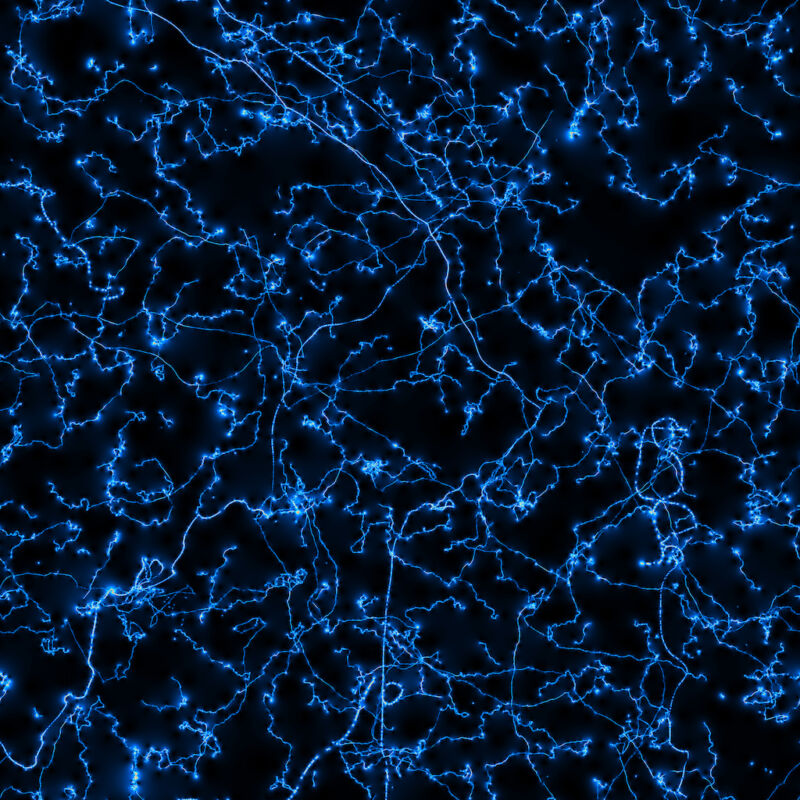
Remember that time in the Lord of the Rings lore when the dwarves of Moria dug too greedily and too deep, unearthing the Balrog, an ancient horror not meant to roam free in the modern age?
Cosmic strings are kind of like that but for physics. They are hypothetical leftovers from the momentous transformations experienced by our Universe when it was less than a second old. They are defects, flaws in space itself. They’re no wider than a proton, but they may potentially stretch across the observable volume of the Universe. They have unspeakable powers—the ability to warp space so much that circles around them never complete, and they carry enough energy to unleash planet-destroying levels of gravitational waves. They’re also the path into some of the most exotic physics known (and unknown) to science.
But perhaps the greatest power cosmic strings possess is their capacity to confound physicists. According to our best understanding of the early Universe, our cosmos should be riddled with cosmic strings. And yet not a single search has found any evidence for them. Figuring out where the cosmic strings are hiding, or why they shouldn’t exist after all, will help push our understanding of cosmology and fundamental physics to new heights.
And no, we won’t need a wizard.
A broken universe
Let’s turn the clock back to some of the earliest moments in the history of the Universe. At that time, the cosmos was less than a fraction of a second old, and its entire observable volume, currently around 90 billion light-years across, was compressed into a space no bigger than an atom.
I’ll tell you straight away that we have no firm understanding of the nature of the Universe at this time. That’s because the matter that filled the Universe was in such an extremely exotic state, with temperatures and pressures so stupidly high, that it’s not even worth typing out numbers for them. At these energies, our current knowledge of physics simply breaks down. We have no well-understood equation, no guiding principles, no experimental results that can tell us what exactly the Universe was up to when it was so young.
But we do have a few sneaking suspicions. We’ve identified through our mathematical models and verified through experiments that the forces of nature aren’t always what they seem. At the normal, typical energies of everyday life, we experience four fundamental forces: gravity, electromagnetism, strong nuclear, and weak nuclear. But at high energies, things shuffle around a bit.
At an energy of around 246 GeV, the electromagnetic and weak nuclear forces cease to be distinct. Instead, they merge into a single super-force known (appropriately) as the electroweak force. And here's something wild: At those energies, there are only three forces of nature, not four. Once you drop below that energy, the electroweak force breaks apart into the more familiar electromagnetic and weak nuclear forces.
In physics, this splitting is called "spontaneous symmetry breaking." The unified electroweak force exhibits a deep mathematical symmetry, but that symmetry can only be sustained at high energies. In our everyday experience, that symmetry is hidden (or broken), and the electroweak’s two component forces appear to be wildly different, even though they’re really manifestations of a deeper, singular force.
Why stop there? Physicists suspect that at even higher energies, the strong nuclear force joins the party, creating a single force known as a GUT—a Grand Unified Theory. This isn’t mere idle speculation. The constants that define the strengths of the forces change with energy, and at high enough energies, they all have roughly the same strengths, signaling that unification is a viable option. Beyond that, at almost unfathomable energies, gravity is also thought to join with the others to create a Voltron of fundamental physics: a Theory of Everything.
reader comments
261